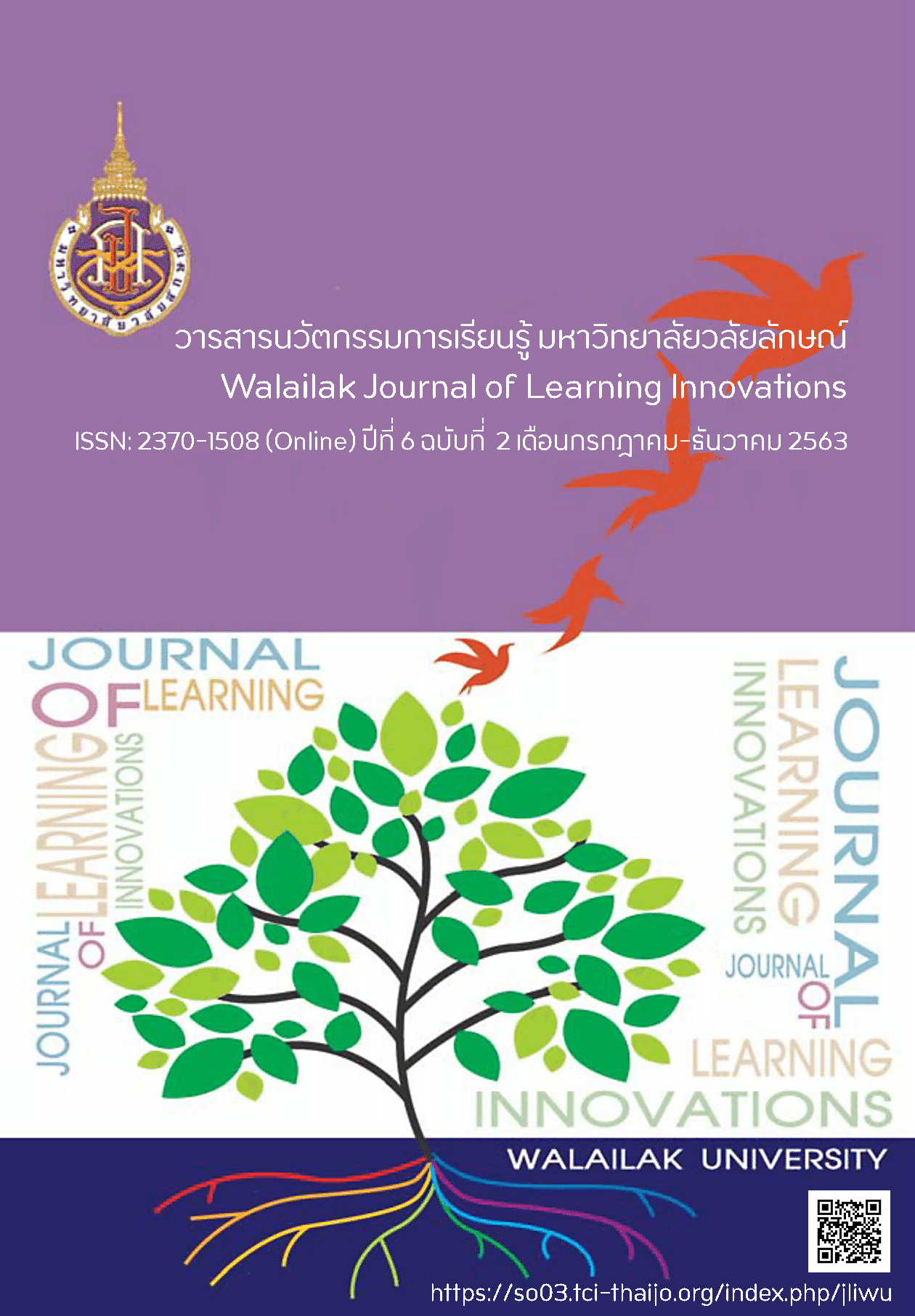Teaching Environmental Management Using Visual Thinking to Promote Learning Attitude and Achievement of Hospitality Students
DOI:
https://doi.org/10.14456/jli.2020.12Keywords:
Visual Thinking, Attitude, Achievement, Environmental ManagementAbstract
The research were interested to study on process of teaching environmental education using visual thinking learning method. The research aimed: 1) to study the development of teaching environmental management using visual thinking learning method, 2) to study and compare environmental learning attitude and achievement of students. The sample were 40 third and fourth year undergraduate students studying in Faculty of Hospitality Industry, Dusit Thani College, academic year 2019, derived by a purposivesampling students enrolled in Environmental Management in the Hospitality Industry subject, in the first semester of the academic year of the study period in 2019. The research instruments were teaching plan (IOC = 0.98), attitude test (Cronbrach’s Alpha Confident = 0.898) knowledge test.
The study showed that after learning by using visual thinking learning method, learning achievement posttest score of students who were taught by using visual thinking learning method was higher than pretest at the .05 level of significance. The mean of the difference of the attitude towards environmental management before learning ( = 3.61, SD = 0.72) and the attitude towards environmental management of post-learning by using visual thinking learning method (
= 4.21, SD = 0.71) were statistically significant, indicated that to teaching environmental education using visual thinking learning method to be reverse their environmental knowledge and attitude.
References
Ajzen, I. (1991). The theory of planned behaviour. Organization Behaviour and Human Decision Process, 50, 179–211.
Barisri, A. (2017). Development of an instructional packages in science with concept map entitle life and the environment for Prathomsuksa 6 students. (Master’s Thesis, Rajabhat Maha Sarakham University).
Chankao, K. (1993). Environmental education. Bangkok, Thailand: Kasetsart University.
Jansamood, C. (2011). Principle of environmental impact accessment. Kalasin, Thaialnd: Rajabhat Kalasin.
Kritruenonowng, A. Rattananan, S., & Ryalie, S. (2018). Visual communication learning method for learning skills “words becoming visual”. In RSU National Research Conference 2018, (pp. 327-339). Bangkok: Rungsit University.
Limpriwatana, K. (2012). Using visual thinking strategies to promote oral presentation and self-confidence among Mathayom Suksa 4 Students. Master of Education (Teaching English), Graduate School, Chiang Mai University.
Phuwiphadawat, S. (2001). Learner Centeredness and Authentic Assessment. Chiangmai: The Knowleage Center.
Saenmontri, P. (2015). Development of English lessons using visual thinking strategies to promote English speaking and English creative writing abilities among Mathayom Suksa 5 students. (Master’ Thesis, Chiang Mai University).
Sword, L. (2005). The Power of visual thinking. Retrieved September 5, 2020 from http://www.giftedservices.com.au /handouts/Thinking.doc
UNESCO. (1978). Connect UNESCO-UNEP Environmental Education Newsletter. Retrieved August 20, 2020 from http://unesdoc.unesco.org/images/0015/001563/156393eb.pdf
Yokin, J. (2017). Active learning. Retrieved September 15, 2020 from http://nakhonnayok.dusit.ac.th/article
Downloads
Published
How to Cite
Issue
Section
License
เนื้อหาและข้อมูลในบทความที่ลงตีพิมพ์ในวารสารนวัตกรรมการเรียนรู้ มหาวิทยาลัยวลัยลักษณ์ ถือเป็นข้อคิดเห็นและความรับผิดชอบของผู้เขียนบทความโดยตรง ซึ่งกองบรรณาธิการวารสาร ไม่จำเป็นต้องเห็นด้วย หรือร่วมรับผิดชอบใดๆ
บทความ ข้อมูล เนื้อหา รูปภาพ ฯลฯ ที่ได้รับการตีพิมพ์ในวารสารนวัตกรรมการเรียนรู้ มหาวิทยาลัยวลัยลักษณ์ ถือเป็นลิขสิทธิ์ของวารสารนวัตกรรมการเรียนรุ้ มหาวิทยาลัยวลัยลักษณ์ หากบุคคลหรือหน่วยงานใดต้องการนำทั้งหมดหรือส่วนหนึ่งส่วนใดไปเผยแพร่ต่อเพื่อกระทำการใดๆ จ้อต้องได้รับอนุญาตเป็นลายลักษณ์อักษรจากวารสารนวัตกรรมการเรียนรู้ มหาวิทยาลัยวลัยลักษณ์ก่อนเท่านั้น


